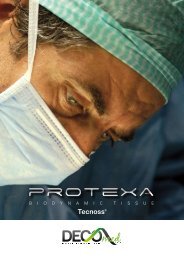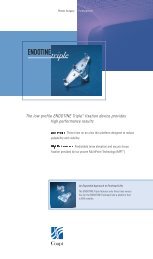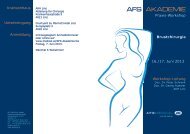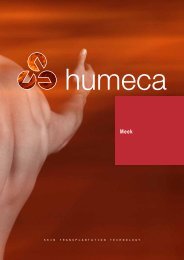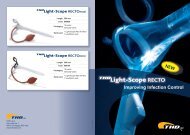MEEK Micrografting - AFS Medical
MEEK Micrografting - AFS Medical
MEEK Micrografting - AFS Medical
You also want an ePaper? Increase the reach of your titles
YUMPU automatically turns print PDFs into web optimized ePapers that Google loves.
Axilla and upper arm,<br />
21 days post burn, before operation<br />
Gauze applied to the wound (upper arm)<br />
Gauze secured with staples<br />
Gauzes and parts of gauzes on the wound Initial result after the first transplantation Re-grafting: a gauze is cut into pieces<br />
to graft smaller areas on the thorax<br />
<strong>MEEK</strong> case<br />
By dr. A.W.F.P. Vloemans, surgeon at<br />
Red Cross Hospital Beverwijk, The<br />
Netherlands<br />
An 84 years old woman was<br />
admitted in our burns centre<br />
because of a burn wound she<br />
sustained in the kitchen. While<br />
taking a kettle from the gas<br />
stove her nightgown caught fire.<br />
At first she did not notice, but<br />
after a while she saw her clothes<br />
burning. She put out the flames<br />
and cooled the burns under the<br />
shower.<br />
On admission we saw a healthy<br />
obese woman with burns at the<br />
right upper arm, axilla and<br />
thorax. The total body surface<br />
area burned amounted 11%;<br />
about 9% of which was full<br />
thickness. The borders between<br />
full thickness and partial<br />
thickness were not sharp.<br />
The medical history recorded<br />
insulin dependant diabetes and<br />
a stroke. As medication she also<br />
used acetylsalicylic acid.<br />
Topical treatment consisted of<br />
daily application of Silver<br />
Sulfadiazin 1% cream dressings.<br />
Resuscitation was applied by<br />
means of an isotonic saline<br />
solution and fluids ad libitum.<br />
Insulin medication was<br />
continued, based on blood sugar<br />
levels and also treatment with<br />
acetylsalicylic acid was<br />
continued.<br />
As an early tangential excision<br />
was expected to cause a great<br />
blood loss and as the distinction<br />
between partial and full<br />
thickness was not clear, a<br />
secondary excision and grafting<br />
after healing of the partial<br />
thickness burns was performed.<br />
Operation took place on post<br />
burn day 21; five days earlier<br />
treatment with acetylsalicylic<br />
acid was discontinued. The<br />
wound bed consisted of<br />
granulation tissue and<br />
remainders of necrotic dermis.<br />
Debris was excised using a<br />
dermatome. Haemostasis was<br />
performed by means of the<br />
application of an adrenalin<br />
solution to the excised wound<br />
bed. A thin split thickness skin<br />
graft was harvested from the<br />
right upper leg.<br />
Ten Meek gauzes 1:6 were<br />
prepared and applied to the<br />
wound. After fixation with staples<br />
the wound was covered with<br />
gauzes soaked in a silvernitrate<br />
solution. The donorsite was<br />
dressed with polyurethane foam<br />
dressing.<br />
After 6 days the <strong>MEEK</strong> gauzes<br />
were removed from the wound.<br />
The graft take appeared to be<br />
about 80%.<br />
Two weeks after the first<br />
operation, parts of the wound<br />
where the graft had not taken<br />
because of insufficient excision<br />
at the first operation, were<br />
excised again and grafted with<br />
Meek gauzes 1:4. Parts of the<br />
wound with a good graft take,<br />
but insufficient outgrowth of<br />
epithelium were also re-grafted.<br />
After the second operation only<br />
minor defects remained,<br />
requiring only daily application of<br />
a topical antibacterial dressing.<br />
Five weeks post burn the patient<br />
was released from hospital.<br />
4





